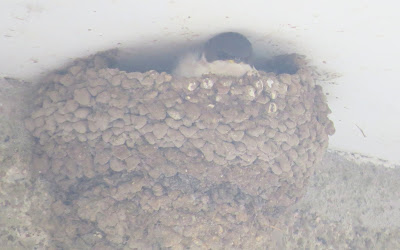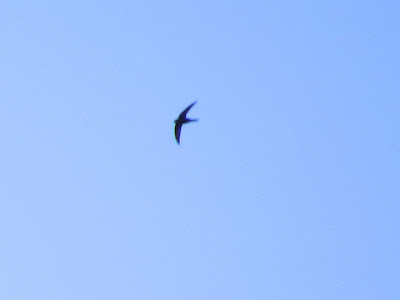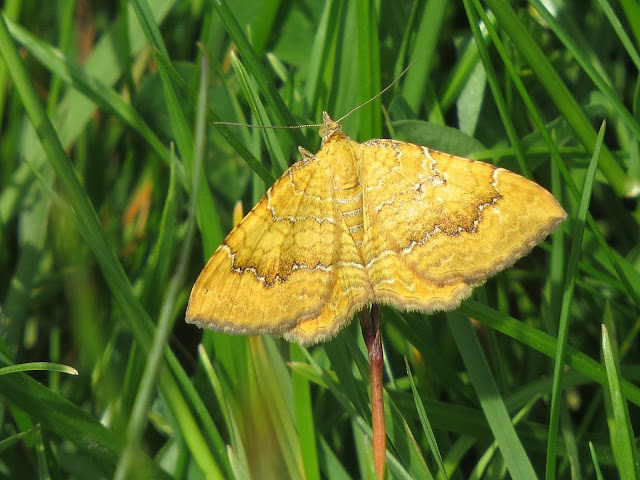When we converted our barn to our home, we forgot to tell the local swallows. Not that swallows have ever nested in the barn (they're well catered for in the old barns along the lane) but they do like to play around it. They have aerial games of catch just above it, where one drops a feather and another one picks it up (the adults play at this when they first arrive back here in the spring). And over the years, the swallows have also liked to investigate the barn by swooping in and out of it.
But now the barn is a house, there can't be any more playing in there!
The newly arrived swallows haven't realised this, of course - and twice recently a playing pair have flown right inside when the kitchen door has been wide open. The last time this happened, I was gardening just outside and the birds flew straight over my head and into the kitchen. In folklore, a swallow in the house means 'joy'. Well, that may be so, but I only saw chaos! The two birds flew around chattering and trying to find their way out. One found managed it quickly, but I had to rescue the other one.
I held the bird for a moment before releasing it. It's incredible to think that not long before it had just flown all the way back from Africa. What a wonderful little creature it is.
I'd love to have swallows nesting on the smallholding, but as they seem happy with various sites around here I believe it's other birds that need the help - like the returning swifts. Increasingly, old houses with eaves where they can nest are being pulled down - and these are being replaced with new (ironically) environmentally friendly houses that don't accommodate them. And even in the older houses, local householders are putting up wires and nets to prevent birds nesting there.
In the past, people were obviously far more relaxed about living with birds nesting in their roof. Gilbert White, the eighteenth century naturalist wrote in 1778 of his village in Hampshire:
"The swallows and martins are so numerous and so widely distributed over the village, that it is hardly possible to count them; while the swifts....about half of which reside in the church, and the rest build in some of the lowest and meanest thatched cottages."
It seems that even ordinary folk in their humble cottages accepted these birds in the roof.
 |
| Spotting house martins nesting last year on a murky day in Cornwall |
My local community's attitude to birds' nests and houses has only recently changed. I remember as a child house martins nesting next door and sparrows nesting under our roof. But I don't know of any house martins nesting around me now, despite living in a village full of old buildings - and I only know of two buildings in this area where swifts are nesting (one of these is a church, the other the old, converted workhouse building).
So to help the swifts, I've put up some nest boxes on our house.
To tempt them in, I've been advised to play a CD of swift calls because swifts like to nest where other swifts are already nesting. I wasn't sure about playing this, but it's actually very soothing to listen to - a bit like listening to a recording of the dawn chorus. I play it from the bedroom window in a short burst on fine evenings and passing swifts coming in from the fields do seem interested. High up in the sky, they fly around for a bit when it's playing (this makes me feel like a sort of Pied Piper.) I won't tempt swifts to change nest sites (they are very loyal to their sites) but I hope to interest those who are looking for somewhere new to nest, particularly young swifts looking for next year. These amazing birds will remember potential nest sites when they come back from Africa in the spring.
 |
| Hopefully with Swifts nesting at home I'll manage better photos of them! |
On the other side of the house, we've put up nest boxes for sparrows. We only have a couple of sparrows here in the lane, and I hope that providing a nest site will help increase their number. But this year the sparrows haven't nested there. Instead, they've been commandeered by something else altogether..
We have lots of blue tit boxes here, but obviously this pair found the sparrow box much more desirable. The young must be ready to fledge because they're at that noisy (and inquisitive) stage where they keep sticking their heads out the nest hole.
But next year, hopefully, the sparrows will find the box instead.















